
Martin Brundle reveals his F1 driver of 2025
Veteran broadcaster and F1 driver Martin Brundle has picked out the contender he's been most impressed with this year
“Flawless” Mercedes dominates in Barcelona: the complete report on the 2019 Formula 1 Spanish Grand Prix
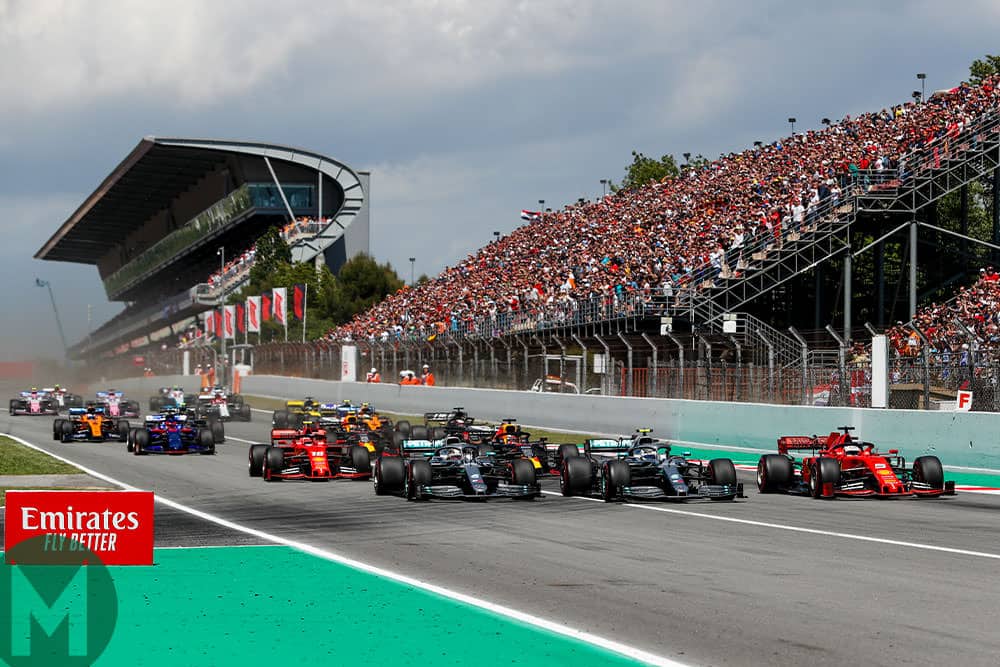
All images: Motorsport Images
There was nothing circumstantial about this resounding Mercedes 1-2. Lewis Hamilton beat polesitter Valtteri Bottas off the line and stayed in front throughout. During the course of what may have been the final Spanish Grand Prix for the time being, the Ferraris tripped over themselves three times, costing them third position to the immaculately-driven Red Bull of Max Verstappen.
Other than a bit of strategic uncertainty about one-stop versus two, that was the essence of it. The Mercedes W10 would have delivered the team its fifth consecutive 1-2 regardless of the way the strategies played out. The dominant factor this weekend was the increased performance advantage Mercedes had over the field – either through the car being let loose upon the track that’s most demanding of aerodynamics, or through the effectiveness of its upgrades. It was significantly faster than the Ferrarithrough every single corner, a cumulative advantage that the Ferrari’s lower drag couldn’t begin to counter. The Mercedes was particularly devastating through the slow turns of the final sector where that rear-wheel-steer element of the rear suspension seemed particularly valuable.
But regardless of the flawless job of Mercedes, Ferrari is contriving somehow to not fully access its car. There were many corners here where it was slower than the Haas – a car with the same suspension and engine but which the SF90 has habitually had 0.5sec on. Subtract 0.5sec from the Ferrari’s lap time and it would at least be giving the Mercedes a race. Away from the low-drag demands of Baku and back onto a normal downforce track, it was no faster than the Red Bull and further away from the Mercedes than it’s been all season. After the race team boss Mattia Binotto was even allowing that the whole car concept may ultimately be behind the car’s limitations. Which is less than great news for the championship.
So Dr Zetsche, in his last race as Daimler CEO before retirement, got to stand on the Circuit de Catalunya’s podium and be hoisted up onto the shoulders of Hamilton and Bottas.
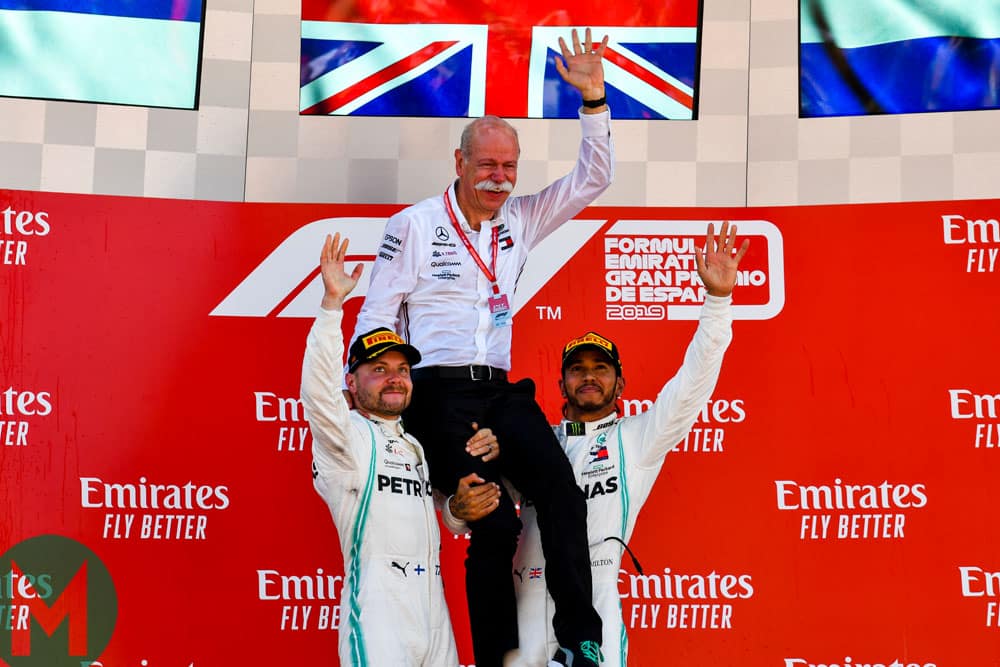
“Did I just read that right?” tweet-questioned Damon Hill. “Valtteri Bottas 0.6sec faster than Lewis Hamilton?” Nothing wrong with the ’96 champ’s eyesight. That was the reality as revealed by the Barcelona timing beam. Yes, Hamilton had compromised himself badly, but that wasn’t all of it: Bottas had tuned himself into the heavily upgraded car’s sweet spot and had built from there, every time he got into the car, carrying that same sense of purpose he’s had all year. “In every run I found room for improvement,” he said, “little bits here and there, and I managed to get everything together in Q3.” Even a sloppy out-lap spin into the Turn Six gravel on cold tyres in that morning’s practice didn’t break his rhythm; he just had a better handle on things this weekend than the guy on the other side of the garage.
Hamilton had scrabbled a time within 0.1sec of Bottas’ subsequent run in Q2, but it didn’t come together for him thereafter. First of all, there were yellow flags at the end of Q2 which caused Hamilton to abandon his lap immediately. The resultant lack of an in-lap meant his battery wasn’t going to be fully charged for his Q3 out-lap. Trying to charge the battery and treating the delicate tyres gently are two conflicting requirements: aggressive braking, fast-slow. So it needed to be done on a relatively empty track – so he set out very early on that lap. He didn’t manage to get the tyres properly prepared and they were under-temperature as he powered out of the final corner with an oversteer snap to begin the lap. That left him 0.6sec adrift of Bottas’ confident and committed first effort. Then the wind came up quite dramatically, a big headwind up the long start/finish straight, a crosswind through the fast Campsa – and someone had scattered gravel around Turn 13. So no-one improved during the final runs and, in addition, Hamilton was badly placed in traffic. So those first runs stood as the grid times.
Its deficit to the Merc had increased – but then so had everyone else’s
The margin by which Bottas beat Hamilton was just one of the surprises of qualifying. The other was the margin of Mercedes’s superiority over Ferrari. Both cars arrived here heavily modified. The Mercedes W10 carried a revised front wing that worked in conjunction with a radically reconfigured barge board. There were three extravagant vortex generators within that hideous-looking complexity where before there’d been one, suggesting that a major unblocking of the airflow passage up and/or downstream had been achieved (enabling extra vortices to work in creating more downforce without losing the advantage of that with more drag). The implication was the speed of the flow down the lower flanks of the bodywork and through the gap between the rear wheel and diffuser had been significantly increased, pulling harder on the underfloor flow and increasing downforce that way. It was one of the most powerful aero upgrades Mercedes has ever conceived, reckoned to be worth at least 0.3sec.
In addition to the bodywork upgrades seen on the Ferrari at Baku, here there was a revised front wing with a wider footplate, aiding the outwash around the front tyre and thereby also helping speed up the flow down the bodysides. Then there was the upgraded power unit two races early, slightly more powerful and triggered by a new lubricant from Shell. It was not as powerful an upgrade as Mercedes’s – not around Barcelona, at least. This track gives greater lap time reward for aerodynamic performance than any other – and Mercedes’s advantage over the rest of the field was enhanced considerably. Some of that will be the effectiveness of its upgrade, some almost certainly just the track format giving greater rewards than usual for its already greater aero performance. “We are faster down the straights,” pointed out Vettel, something backed up by the SF90 consistently being the fastest in sector one, “but we are losing much more lap time by our speed through the corners.” The latter fact was reflected in a gaping 0.635sec deficit to Mercedes in the slow final sector. Over the lap, third-quickest Vettel was 0.866sec adrift of Bottas’ pole. Charles Leclerc compromised himself by running heavily over the Campsa exit kerb and damaging the Ferrari’s bodywork, obliging him to do a second Q2 run, thereby using up an extra set of soft tyres. Which left him doing a single multi-lap run in Q3. He was almost 0.3sec shy of Vettel, only fifth-quickest.
By general consensus, the heat ensured the track was considerably slower than during the cool of winter testing. Furthermore, we can’t know exactly what was being run back in January, but it makes an interesting comparison nonetheless of individual cars then to now. Ferrari was quickest in January with a 1min 16.2sec lap, a time that Vettel pretty much equalled on a slower track on Saturday. Mercedes had matched that 16.2sec on the final day of testing, but Bottas’ pole was 1min 15.4sec. Mercedes had found 0.8sec, around 0.3sec of which was this upgrade. Red Bull had found 0.7sec since then, Haas and Toro Rosso 0.3sec. The rest qualified slower than they’d managed on the faster January track.
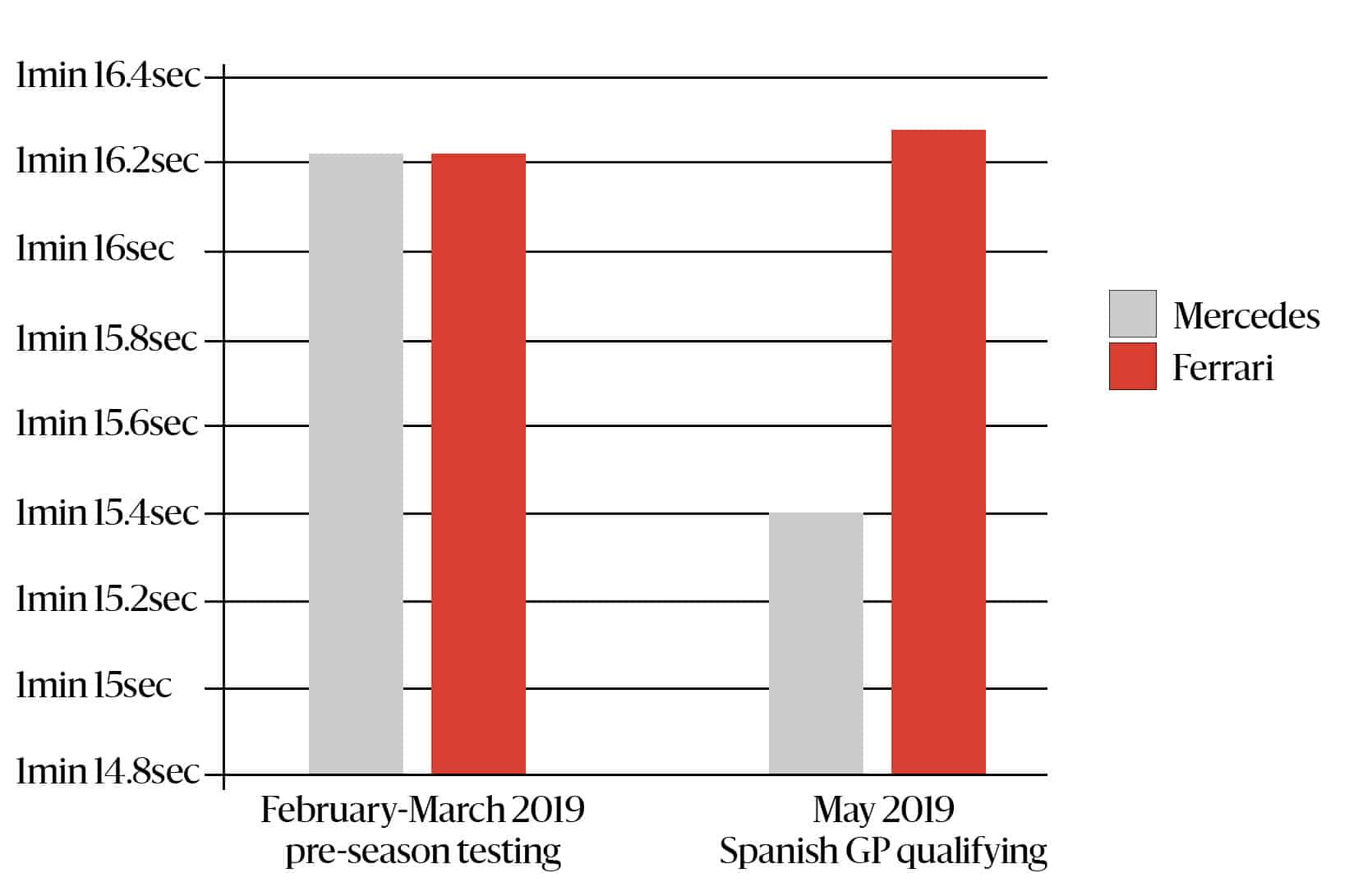
The difference between the two cars was at its starkest in the slow final sector, into and through the chicane. Part of the challenge was keeping the rear tyres alive by the end of the lap to give you the required traction there – something that wasn’t an issue in January. So that aspect of Ferrari’s weakness was punished here on a track temperature of around 39deg C in a way that it wasn’t during testing.
Max Verstappen managed to slot his Red Bull in between the Ferraris, fourth fastest. The RB15 featured upgraded barge boards and but for a snap of oversteer out of the chicane on his final lap, might have grabbed third from Vettel. He felt the balance of the car to have improved, but actually its deficit to the Mercedes had increased (see below) – but then so had everyone else’s. That’s how good the Mercedes was at Barcelona.
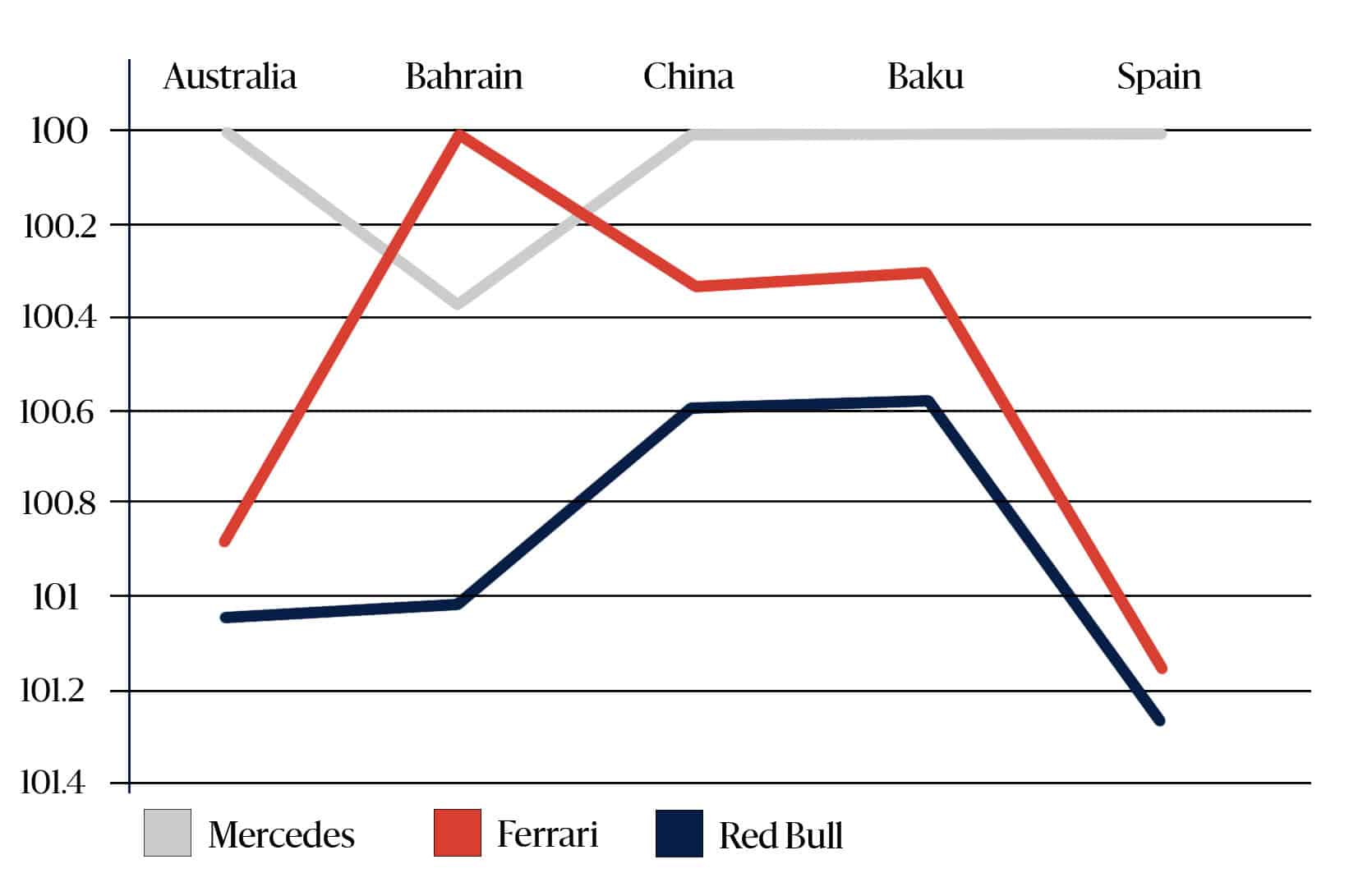
Pierre Gasly was around 0.3sec adrift of Verstappen in the sister Red Bull, putting him sixth and only a couple of tenths ahead of Romain Grosjean in the first of the heavily upgraded Haas VF-19s. On a track with such high energies being fed into the tyres, there was no hint of its recent rubber difficulties. Kevin Magnussen was just a few hundredths behind in the sister car. The Toro Rosso was within around 0.3sec of the Haas and after working away at refining a set-up through the weekend, Daniil Kvyat got his comfortably through to Q3, in ninth. Team-mate Alex Albon had been more quickly into the groove but made a series of small errors when it counted and didn’t get out of Q2, in 12th. “I just tried something a bit different into Turn Five and pushed too much on the entry which led to a big snap on the exit. Since the tyres are sensitive, I was fighting the rest of the lap with the rear tyres and trying to keep them in the window, but I could tell they were sliding too much.”
Tenth fastest Daniel Ricciardo probably punched above the Renault’s weight in getting through to Q3 with a car that was around 1sec slower than the Haas, but would take a three-place penalty for his collision in Baku. In the other Renault, Nico Hülkenberg went off in Q1, damaging the new spec front wing. He managed to wrestle the damaged car back, had an old-spec wing fitted, but couldn’t get out of Q1, in 16th. He was then obliged to start from the pitlane for the change of wing specification.
On general performance, one of the McLarens should probably have been in Q3 at the expense of Ricciardo but both Lando Norris (11th) and Carlos Sainz (13th) made crucial errors on their final Q2 runs. The MCL34 featured new front wing and barge boards but was still carrying a general understeer balance. This was true also of the Alfas which, in addition, were not braking particularly well. It was all Kimi Räikkönen could do to go 14th, around 0.5sec off McLaren with Antonio Giovinazzi failing to make it past Q1, 0.5sec slower again and ahead only of the two Williams. A gearbox penalty would lose him a further place to Kubica on the grid.
The updated Racing Point was not at its best around this track and Sergio Pérez only just scraped it into Q2 where he was 0.1sec adrift of Räikkönen. In the other Racing Point, Lance Stroll was a couple of tenths off and has still yet to break out of Q1 this season. Although taking a gearbox penalty after damaging the original with a practice off, George Russell was the quicker of the Williams by an unusually big margin as Robert Kubica found his car developing ever-worsening oversteer throughout the weekend. On Friday he’d done a time within 0.3sec of his eventual qualifying time when using a harder tyre, lower engine mode and much heavier fuel load – so something wasn’t quite right.
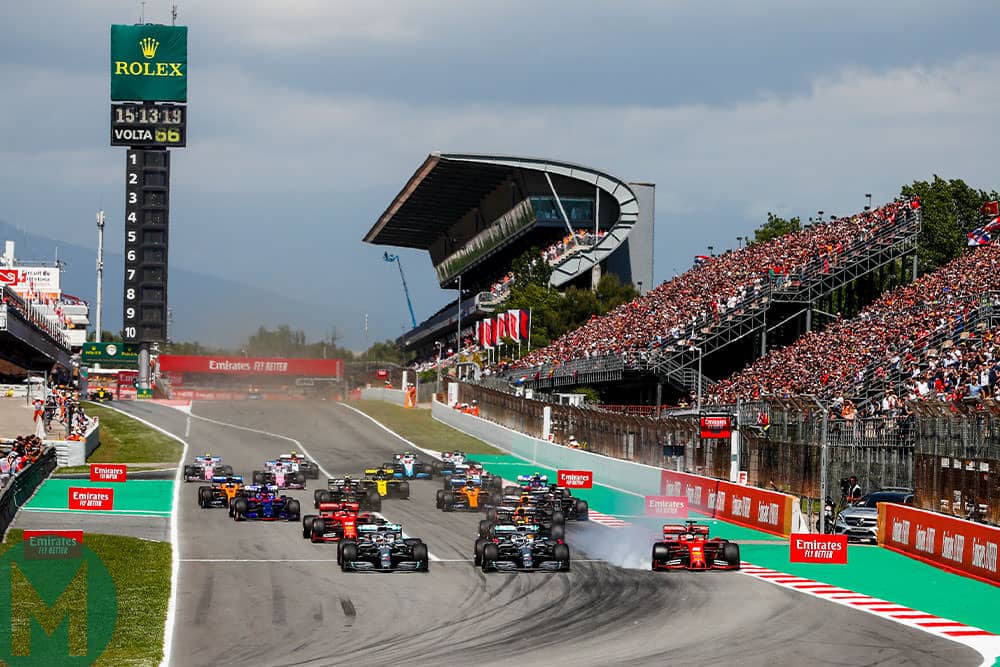
Both Mercedes drivers have been practising clutch release techniques this year; it can be all that separates the difference between winning and being first of the losers. Hamilton’s at 3.10pm in Barcelona, was near-perfect. Bottas’ wasn’t – but he felt it wasn’t down to his technique. “I lost it at the start,” he said afterwards, his mood dark. “I had a strange behaviour on the clutch; biting, releasing, biting, releasing. I’ve never had it before. So I lost it there. I’m keen to find out why the start was so bad and why the issue happened.”
Hamilton was able to remain on the inside line of his second grid place and with the better start be perfectly placed. Vettel was another to take advantage of Bottas’ iffy start and had the Ferrari alongside on the outside – so making it three abreast, with Bottas in the middle. This rather spoilt Bottas’ initial plan of going around the outside of Hamilton so as to have the inside for Turn Two – for he now had to fight for space with the close-proximity Ferrari.
Vettel had to go for it at this point. It was going to be his only opportunity of at least splitting the Mercedes. “So I was determined to be the last to brake.” He achieved this aim. But as Hamilton was through and away, Vettel locked up his outer front tyre trying to chop ahead of Bottas and in that moment flat-spotted it. After light contact with Bottas’ tyre, he hung himself out over the extremes of the kerb, losing momentum. Bottas just managed to hang on, getting a bit of a tank slapper in his eagerness to put the power down, Vettel then switched across the back of the Mercedes through Turn Two – into the path of team-mate Leclerc who was forced to back off. As with their very similar first turn situation in Melbourne, Leclerc said, “I think he didn’t see me.”
Vettel’s eyeballs were being shaken in their sockets from the effects of the flat-spot
Verstappen had seen all this building up and had deliberately backed off on the approach to Turn One, knowing that this would allow him better momentum – and it worked beautifully, as he sailed around the outside of both Ferraris through turn three. Gasly too had better momentum than Leclerc and tried for a similar move around the outside, but this just led to him taking to the run-off as Leclerc defended hard. This allowed Grosjean to challenge Gasly up to Turn Four, but the Red Bull driver managed to just grind ahead on the exit. As this was playing out, just behind them Magnussen stole down Kvyat’s inside – the beginning of a long-running duel between the Haas and Toro Rosso. Then came Sainz, Albon and Ricciardo. Norris had taken a hit from Magnussen and lost momentum, dropping down near to the back as the pack swarmed around him. Räikkönen took a trip through the Turn Four gravel and emerged out the other side at the back of the pack. Hülkenberg was already making progress from his pit lane start.
Hamilton blitzed the first lap, Bottas immediately falling back out of tyre-damage range while keeping a wary eye on Verstappen in the mirrors. Vettel’s eyeballs were being shaken in their sockets from the effects of the flat-spot, but he was able to maintain reasonable pace for the time being. Leclerc initially had his hands full with the closely following Gasly and Grosjean before things settled down and he was able to make inroads into the limping sister Ferrari ahead of him.
By the fifth lap the Ferrari airwaves were buzzing and there was that familiar team principal frown on the pit wall. Vettel was struggling and being asked to hurry up, Leclerc was urging to be set free to chase Verstappen before the Red Bull got away. Vettel was pushing as hard as he dared on his damaged front tyres but if his race wasn’t to be hopelessly compromised, he needed to get them to run a while longer yet.
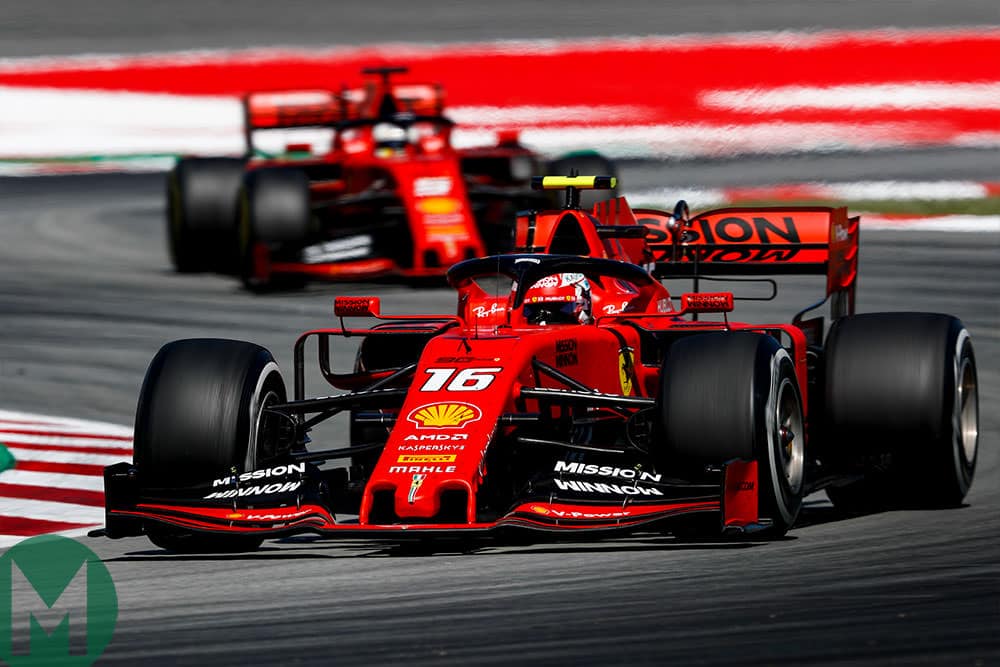
The soft compound tyres that the top 10, and most of the rest, started on were reckoned good for at least 25 laps. At Mercedes they were planning on lap 29/30 for the first stops if all went to plan. It was a good amount faster than the more durable medium. The hard was slow and difficult – prone to dropping out of its temperature window. Getting to lap 29/30 on the softs would, in theory, have allowed a one-stop, with a second stint on mediums. That’s assuming you weren’t pressured into stopping early by undercut pressure from behind. But by the fifth lap or so Verstappen was far enough behind for it to be apparent that wasn’t going to be an issue for Mercedes. But still, it might migrate to a two-stop, as 36/37 laps on the mediums would take them right up to their wear limit and might require a bit of careful managing from the drivers.
So as Leclerc glued himself to the back of Vettel, it was far too early to bring Seb in for a tyre change. But it was obvious they needed to swap position. The team gave Vettel at least four laps too long to either speed up (which he couldn’t do) or move aside. The instruction for him to do so was eventually given on the 11th lap. Once past, Leclerc immediately put big distance between them as he tried to chase down the 4.5sec gap to Verstappen.
By this stage of the race the Mercedes would be rounding the final turn onto the pit straight as Leclerc was still between Turns 12-13 and Verstappen just approaching the chicane. There was surely more in hand at Mercedes if needed. This was just the gap that resulted from Mercedes’s tyre life-extending pace. Bottas was not at any stage racing his team-mate, knowing it would be counter-productive.
“Let’s get off these tyres,” said Vettel around this time. “Have we got a gap [to the cars he’d drop into after stopping]?” No, he didn’t. “Well, I suggest you find one. I don’t care if it’s traffic.” He was brought in at the end of lap 19. The stop was slow – a cross-threaded left-rear wheelnut – at 4.4sec, which cost him two places, preventing him clearing the Toro Rossos. He rejoined now on fresh mediums but seemingly consigned to a two-stop by the 41 laps that still stretched out ahead of him.
Leclerc meanwhile had been working on that gap to Verstappen and by the time of Vettel’s stop had it down to 3sec. As he further stepped up the pace, this was all the undercut pressure needed to induce Red Bull into bringing their man in at the end of the 20th lap. It caused something of a stir by putting him on another set of softs – thereby transmitting its two-stop plans. This was done to ensure a fast out-lap pace in case Ferrari had responded with Leclerc. It didn’t – and concentrated now on trying to extend Charles’ stint long enough that he could remain on a one-stop and thereby always retain track position over Verstappen, even if that would have entailed a very defensive few laps at the end.
Gasly had dropped well off the back of Verstappen/Leclerc but before pitting on lap 22 had pulled out over 10sec on the two Haas cars behind him, Grosjean still ahead of Magnussen. But the latter was vulnerable to an undercut from Kvyat who was doing a great job keeping the pressure on a faster car. So Magnussen was brought in first, in response to the Toro Rosso stopping, with Grosjean following a lap later and emerging still ahead, but with a reduced gap. Impressively, Kvyat would later pass Magnussen on track.
Ferrari left Leclerc out until lap 25, by which time his pace was dropping off badly, the Ferrari shredding its rubber away more quickly than the Mercedes. He was fitted with the hards – a clear indication of Ferrari’s one-stop plan, as it didn’t feel confident the mediums would’ve made the remaining 41 laps. As with Vettel, his stop was delayed by a cross-threaded nut on the left-rear wheel. Because Vettel and Verstappen, at the very least, were certain to be two-stopping, the Mercedes pitwall began to think in terms of possibly migrating to that to cover them off – and asked their drivers to pick up the pace, so as to retain the appropriate gaps. But as they did that, so the tyres began to wear disproportionately and that lap 29/30 target began to look unfeasible.
Leclerc’s stop finally cleared a gap for the Mercedes to drop into and – as both Hamilton and Bottas were already reporting their struggle with the rubber (Hamilton’s inner rear having a ring of blisters around its circumference) – they were brought in early, Bottas and Hamilton coming in on laps 26 and 27 respectively and getting underway on fresh mediums. The idea was to try to remain on a one-stop but to carefully monitor the wear and be prepared – before it was too late – to bail out of that and switch to a two-stop if necessary. Either way, they had it covered.
More:
With the first round of stops done, Hamilton led Bottas by around 10sec. The gap between them had rather ballooned: “On this type of track you only need to be within four seconds and you’re sliding quite a bit around,” explained Bottas. “I’ve been ahead and I know the difference, how much it makes when you can really focus on saving the tyres where you want to and, in the free air, it’s quite a bit better. So why the gap became bigger? I had to go through some of the slower cars and, at the same time, my tyres started to drop off. With less surface on the tyre I lost a bit of temperature. So yeah, my tyres were finished much earlier than Lewis’. That’s why the gap became better.”
Verstappen was hanging on within a further 5sec but needing to stop again. Some way back from there were the two Ferraris, one-stopping Leclerc still ahead but going much slower on his slow hard tyres than the quickly-closing two-stopping Vettel on his mediums. Again, some excitation from the Ferrari drivers and on the pit wall. Amid the confusion Leclerc was told they were on the same strategy (therefore he repelled Vettel’s DRS attacks down to Turn One) while Vettel was told they were on different strategies (so making him wonder why Leclerc was defending – and why the team wasn’t moving him aside!). Vettel remained behind for 10 laps before the switch was finally made.
“Ok Valtteri, wear was critical on your first set of tyres,” came the message on Bottas’ radio. It suggested Mercedes was indeed going to switch to a two-stop some time soon, something that Hamilton was encouraging them to do as he felt the grip beginning to fade.
Vettel made his second stop on lap 40, dropping him to 16sec behind Leclerc but on much faster fresh mediums and 25 laps left. He’d actually exited just behind Gasly, but was able to nail the Red Bull under braking into Turn 10 on his out-lap. Verstappen was in three laps later for his mediums and would rejoin still well ahead of Vettel and not far behind the old-tyred one-stopping Leclerc, who was lapping 3sec slower. “No way is he getting to the end,” opined Verstappen of Leclerc’s one-stop attempt.
Verstappen’s stop created the gap for the Mercedes to drop into after their stops. Bottas was brought in first, on lap 45 (to have a used set of softs fitted), as a precaution against accidentally inverting the merited order. If Hamilton had been brought in first and then a safety car had appeared, Bottas would have been able to make his stop with the pack slowed and thereby take the lead from Hamilton. It was as well this precaution was taken for on the very next lap, the safety car came out! There’d been a heavy collision between Norris and Stroll as the former tried to go down the Racing Point’s inside at Turn One. Both were out on the spot. All those who’d yet to make their second stop – and a few of those who hadn’t planned to – were now able to pile into the pits and suffer only a 10sec time loss rather than the usual 21sec. This included Hamilton (also on used softs) who thus secured his place at the head of the queue behind the safety car.
Ferrari brought Leclerc in, rescuing him from his apparently doomed one-stop, to fit a fresh set of mediums, dropping him back behind fourth-placed Vettel. At Toro Rosso a communication mix-up between pitwall and garage meant that Albon’s tyres were readied, but it was Kvyat who was ahead in the stacking queue. This delay as the correct tyres were produced cost both of them time – and lost Kvyat his hard-won position to Magnussen.
With the previous gaps wiped, the order behind the safety car as they prepared to get underway again at the beginning of the 53rd lap was Hamilton, Bottas, Verstappen, Vettel, Leclerc, Gasly, Grosjean, Magnussen, Kvyat, Sainz, Albon, Hülkenberg (one-stopping and thus artificially high up the order), Ricciardo, Pérez, Räikkönen, Giovinazzi, Russell and Kubica.
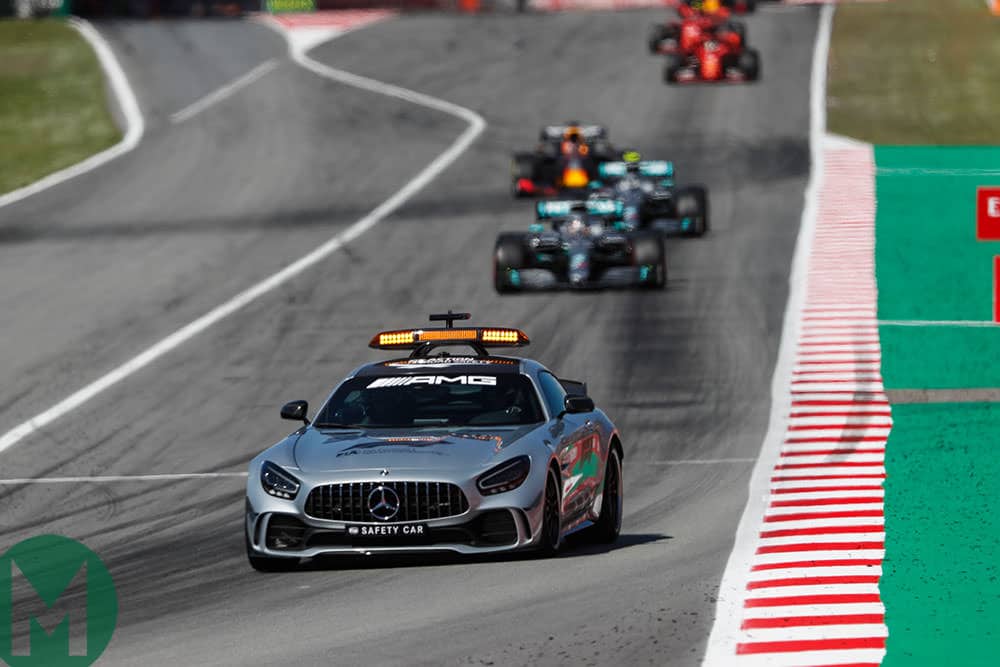
Hamilton blitzed the restart and the soft-shod Mercedes put immediate distance on the medium-tyred Verstappen, Vettel and Leclerc. But Gasly – who’d had softs fitted – was initially quicker than the Ferraris and challenging Leclerc down to Turn One, the Ferrari driver working hard to fend him off. Just back from there, Magnussen slipstreamed team-mate Grosjean perfectly, though it involved a bit of light wheel banging at turn one, Romain taking to the escape road and rejoining now behind. This seemed to throw Grosjean off his stride and he was DRS’d on successive laps by Sainz (who’d just passed Kvyat) and Kvyat himself. Grosjean was able to fend off Albon for the final point (reprising China). Hülkenberg had moved aside for the newer-tyred Ricciardo who joined in the Grosjean/Albon train to the end. Räikkönen passed Pérez on the restart and stayed ahead to the end.
All Hamilton had to concern him once he’d sorted out the restart was getting the extra fastest lap point. He was given the ‘Strat Mode 5’ power setting with which to attack it. Bottas, meanwhile, had backed right off in order to create the space to fully charge his battery – and he too was given the mode. Hamilton 1min 18.492sec, Bottas 1min 18.737sec. Both were then told to call it off, turn the motors back down – and bring the fifth consecutive Mercedes 1-2 result home.
Verstappen yet again maximised, maybe even flattered, his car with his podium finish – though he was aided by Ferrari’s dallying in switching their drivers. But Ferrari’s problems seem to run deeper than just a bit of pitwall mismanagement. “The limitations have become clearer this weekend,” said Mattia Binotto. “There is an understeer balance and not enough downforce. They have been there at the other races. But how long it takes to address is difficult to answer. It may even be the car concept.” Oh dear.
2019 Spanish Grand Prix results

Veteran broadcaster and F1 driver Martin Brundle has picked out the contender he's been most impressed with this year

Alain Prost has given his view on Renault exiting F1 as an engine manufacturer

Mark Hughes weighs up an exceptional 2025 rookie class, dissecting four contrasting debut seasons to reveal who truly stood out the most

Mohammed Ben Sulayem's has now been re-elected as FIA president, after a controversial first term. But how did he become the first non-European president in the FIA's history?